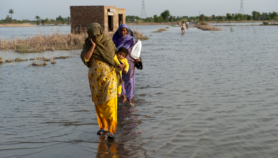By: Bhrikuti Rai
Send to a friend
The details you provide on this page will not be used to send unsolicited email, and will not be sold to a 3rd party. See privacy policy.
[KASKI] The crowd that gathered in a hall near Pokhara airport in the picturesque valley of Kaski in western Nepal, earlier this month (January) was a motley one. Farmers, community forest users, mothers’ groups, development practitioners, local political leaders and a lawmaker quickly settled down to discuss pressing concerns of public participation, financial transparency, accountability of climate change adaptation projects in Kaski district. Such was the intensity of the discussions that the constant drone of aeroplanes landing and taking off across the road was only a minor irritation.
The public discussion programme, organised by Oxfam, Clean Energy Nepal and the Institute for Social and Environmental Transition, Nepal, was aimed at fostering dialogue among stakeholders of the Ecosystem based Adaptation (EbA), funded by Germany and the US -funded Hariyo Ban (Green Forest) programmes in Kaski.
“Climate change adaptation projects in our village are yet to reach the most vulnerable communities affected by changing climate,” says Sagun Gurung of the Lhosepakha community forest group. “How can we address the gaps that need to be filled?” she asks the panellists seated on the dais.
“I am here because we get an opportunity to voice our community’s concerns to the major stakeholders and also learn what is happening outside our villages in terms of project implementation,” she tells SciDev.Net.
According to a 2014 Oxfam study on climate change adaptation finance, Nepal received a total commitment of US$ 538.24 million for climate change adaptation from international public finance sources from 2009 to 2012.
However, only 45.78 per cent of the committed amount is relevant to climate change adaptation with no dedicated funding for public health, energy and water resources, the priority sectors identified by Nepal’s National Adaptation Programme of Action, the study states.
At the discussion, representatives of local NGOs and community forest user groups complained that several climate change projects were focusing on similar issues, leading to duplication.
“The problems stem from the national level,” says Dipesh Chapagain, programme officer at Oxfam Nepal. “Since there is no strict framework or criteria laid down from ministries to implement the programmes, organisations tend to select districts depending on their suitability, which leads to project duplication.”
Similar public discussions on climate change adaptation were also held in the mid-western district of Rolpa and far-western Kailali district last December as part of the Adaptation Finance Accountability Initiative jointly undertaken by Oxfam, Clean Energy Nepal and ISET-Nepal.
As the dialogue proceeded, it was clear that these types of discussions not only encourage locals to communicate their community's concerns, but also allow project-implementing organisations and local administration to explain their side of the story.
“First we identified if the communities we work in were aware about adaptation issues and what they expected of us,” says Gyanendra Subedi, field supervisor of EbA’s project in Panchase, Kaski. “Despite the short timeframe of two years of project implementation we have been able to generate awareness to some level.”
Arjun Neupane, social development officer at Kaski, admits that there needs to be better coordination between government and non-government bodies from national to community level to ensure accountability and transparency. "Unless there is coordinated effort to identify issues and allocate resources accordingly, project duplication will continue and they will not contribute to local communities’ needs,” he says.
This article has been produced by SciDev.Net's South Asia desk.














